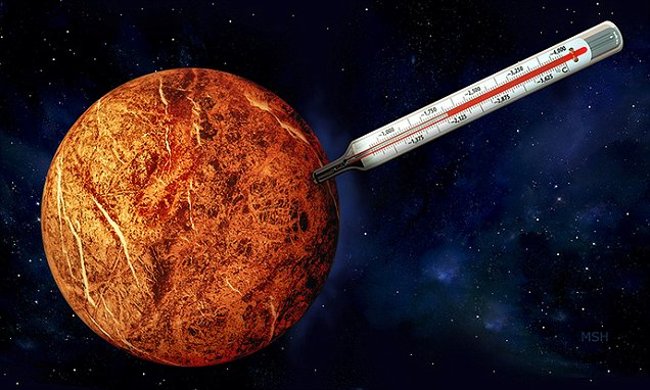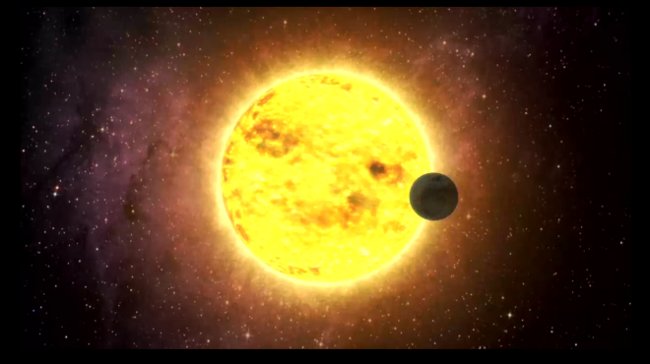Can life really exist in planets - 'can we live'?
Although the planets lie far away from the host stars, they start to heat up and retain that hot temperature. One of the recent studies shows that the temperature of planets is often unstable. Therefore, hot planets often have a hard time keeping water in liquid form - even if they are located in a temperate area around its stars, known as " the area with can live ".
 The temperature of a planet - and whether water can exist in liquid form, an important element of life maintenance - may depend on the history of that world.(Photo source: Michael S. Helfenbein / Yale University)
The temperature of a planet - and whether water can exist in liquid form, an important element of life maintenance - may depend on the history of that world.(Photo source: Michael S. Helfenbein / Yale University)
The author conducted the study of Jun Korenaga - a geophysicist at Yale University who replied to Space.com : " Every living thing in the 'livable area' cannot wait until the planet evolving like the Earth we live in. Even if you consider an Earth like planet made of chemical components - there is enough water and more - the planet It will not be possible to become the "Second Earth" if it is too hot or too cold . "
"Sweating" heat
In the past 60 years, most scientists think that the planets are generally in " moderate " areas.
For example, the heat from the center of the Earth rises through the sheaths and is released through the earth's crust, in the process it is called " convective clothing ". Because convection coat accelerates when the temperature inside the planet increases, the emitted heat may be more or less than that produced in a planet's " mind ", these thoughts have turned lost.
" This is similar to hot-blooded animals with lower body temperatures when sweating, " Korenaga said.
However, by studying the Earth's crust, Korenaga realized that a planet does not necessarily need to reach this equilibrium point. As computer simulations have been improved since the ideas proposed in 1960, a more realistic model of the Earth's crust has revealed problems with early theories.
Korenaga said: " The Earth's crust can adjust itself if it's made of simple materials like corn syrup ." That's because these simple materials can be transformed faster than their complex materials - allowed for self-regulation. " However, Earth's crust is made of very complex materials, " he added.
Korenaga said: " With how the Earth's rock research has been deformed and how does the convection coat adjust itself? ". Korenaga determined that this process does not easily affect the internal temperature of the planets. So, the heat emission on the planet's surface - or " sweating " - does not necessarily end with balancing the amount of heat generated inside the planet. However, this clarification does not necessarily have to be widespread.
David Stevenson , a planetary research scientist at the California Institute of Technology who did not participate in the study, told Space.com : " Korenaga researcher is applying a relatively narrow definition". rules ", but that's very interesting ".
New studies were published last week in Science Advances magazine.
"Hot start ", hot surface
The surface temperature of a planet has a strong impact on what can exist there. If the temperature rises too high, water cannot exist in liquid form, making it a great challenge to life as we know it has grown. When a planet regulates itself, the temperature may be stable, but if a planet is constantly "sweating" the surface may blow too hot steam to the water, causing the water to evaporate.
Therefore, detailed information about the formation and evolution of a planet gave the final clues to its temperature. Korenaga suggests that these materials help form planets along with any effects from large asteroids or comets that may have gone through, which could help determine the temperature on the planet's surface.
Korenaga said: " I guess that a planet with a hot start will maintain its hot temperature and vice versa, " although he also warned that the process of forming planets has not been clarified.

Stevenson said: " But these details are of secondary importance in deciding whether an area can live or not of a planet. The Earth absorbs 5,000 times more energy from the sun than the surface. inside. Things inside play a direct role in determining the surface temperature . "
According to Stevenson, the habitable area is more closely related to the atmosphere of the planet - the things he refers to are related to each other, but there is no need to define what is structured. inside.
But Korenaga points out: " Scientists' understanding of what's inside the planet affects the atmosphere based on a long-term idea, self-regulating planets ."
" The current atmospheric components affect geological activities for several billion years and our understanding of the relationship between the atmosphere and the interior is heavily dependent on, " Korenaga said. The self-regulation concept of the earth's crust, so we need to start from scratch to establish a suitable relationship between the atmosphere and the internal temperature . "
Therefore, the habitat of a planet in the "habitable zone " may not meet the necessary conditions of a planet that exists in life. Korenaga added: " Its internal temperature must also be consistent. Even when starting with the same chemical composition at the beginning, the initial temperature difference will lead to internal components. different atmospheres, thus creating different living areas ".
Korenaga explained further: " However, it is not feasible to conduct research on the inner contents of these strange planets now. All we can do is observe the surface - the atmosphere. - and guess what's inside . "
You should read it
- The discovery of the 'Second Earth' can exist only 4.2 light-years away from Earth
- History of Earth formation and 25 milestones (Part I)
- Top 5 planets may be our 'new houses' in the future
- If people 'occupy' the Sun 2.0 system, how different is life there from Earth?
- Discovering two 'super-Earths' only 12 light-years away can hide life
- Discovering another 'super Earth' can appear to live only 21 light-years away
- 10 interesting facts about the Earth you may not know
- Learn about extraterrestrial super-Earth - Gliese 581c
- Stephen Hawking makes a dreaded view of the future of mankind: 'The Earth has perished, time to leave'
- NASA announces 10 new 'copies' of Earth that we now know
- The mystery of the numbers of Proxima b: The 'Second Earth' on the planet may exist life
- Discovered 20 Earth-like planets that could contain life
May be interested

10 interesting facts about the Earth you may not know

The largest aircraft in the world looks like a 'butt' taking off for the first time

FOMO Syndrome: The more people use Facebook, the more afraid they are to be abandoned

In addition to pyramids, Egypt has a vast labyrinth that is not yet known!

Can astronauts go to catch Pokemon?

Found evidence of Sun storm in wood rings






 NASA announced concussion: 7 Earth-sized planets could have life
NASA announced concussion: 7 Earth-sized planets could have life Living is not merely a survival, enjoy life in a truly meaningful way
Living is not merely a survival, enjoy life in a truly meaningful way If people 'occupy' the Sun 2.0 system, how different is life there from Earth?
If people 'occupy' the Sun 2.0 system, how different is life there from Earth? Top 5 planets may be our 'new houses' in the future
Top 5 planets may be our 'new houses' in the future Photos of 7 planets may exist in the Trappist-1 star system
Photos of 7 planets may exist in the Trappist-1 star system Stop expecting these 7 things in others
Stop expecting these 7 things in others